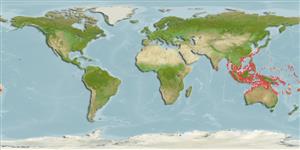Common names from other countries
>
Tetraodontiformes (Puffers and filefishes) >
Monacanthidae (Filefishes)
Etymology: Paramonacanthus: Greek, para = the side of + Greek, monos = one + Greek, akantha ) thorn (Ref. 45335).
Issue
This speces is valid according to several authors in CofF (ver. 11 May 2022).
Environment: milieu / climate zone / depth range / distribution range
Ökologie
seewasser riff-verbunden; ozeanodrom (Ref. 51243); tiefenbereich 34 - 46 m (Ref. 33352). Tropical; 35°N - 31°N, 130°E - 141°E
Northwestern Pacific: confirmed from Japan.
Size / Gewicht / Alter
Maturity: Lm ? range ? - ? cm
Max length : 12.0 cm SL Männchen/unbestimmt; (Ref. 48637)
Rückenflossenstacheln (insgesamt) : 2; Rückenflossenweichstrahlen (insgesamt) : 24 - 30; Afterflossenstacheln: 0; Afterflossenweichstrahlen: 24 - 30; Wirbelzahl: 19. body width 2.0-2.6 in head length; body depth 2.0-3.1 in SL, head length 2.7-3.2 in SL; snout length 3.7-4.1 in SL; eye diameter 2.7-3.7 in head length; second dorsalmost caudal ray elongate and filamentous in male (Ref. 33065).
Inhabits weedy and sandy areas of coastal reefs (Ref. 9710). Found on open muddy substrates from shallow estuaries to deep offshore. Males elongate with age (Ref. 48637). Monogamous (Ref. 52884).
Masuda, H., K. Amaoka, C. Araga, T. Uyeno and T. Yoshino, 1984. The fishes of the Japanese Archipelago. Vol. 1. Tokai University Press, Tokyo, Japan. 437 p. (text). (Ref. 559)
IUCN Rote Liste Status (Ref. 130435)
CITES (Ref. 128078)
Not Evaluated
Bedrohung für Menschen
Harmless
Nutzung durch Menschen
Tools
Zusatzinformationen
Download XML
Internet Quellen
Estimates based on models
Preferred temperature (Ref.
115969): 24.6 - 28.4, mean 27.6 (based on 106 cells).
Phylogenetic diversity index (Ref.
82804): PD
50 = 0.5000 [Uniqueness, from 0.5 = low to 2.0 = high].
Bayesian length-weight: a=0.01862 (0.01139 - 0.03045), b=2.86 (2.72 - 3.00), in cm Total Length, based on LWR estimates for this species & (Sub)family-body (Ref.
93245).
Trophic level (Ref.
69278): 2.8 ±0.25 se; based on food items.
Widerstandsfähigkeit (Ref.
120179): mittel, Verdopplung der Population dauert 1,4 - 4,4 Jahre. (Fec = 3,300).
Fishing Vulnerability (Ref.
59153): Low vulnerability (10 of 100).
